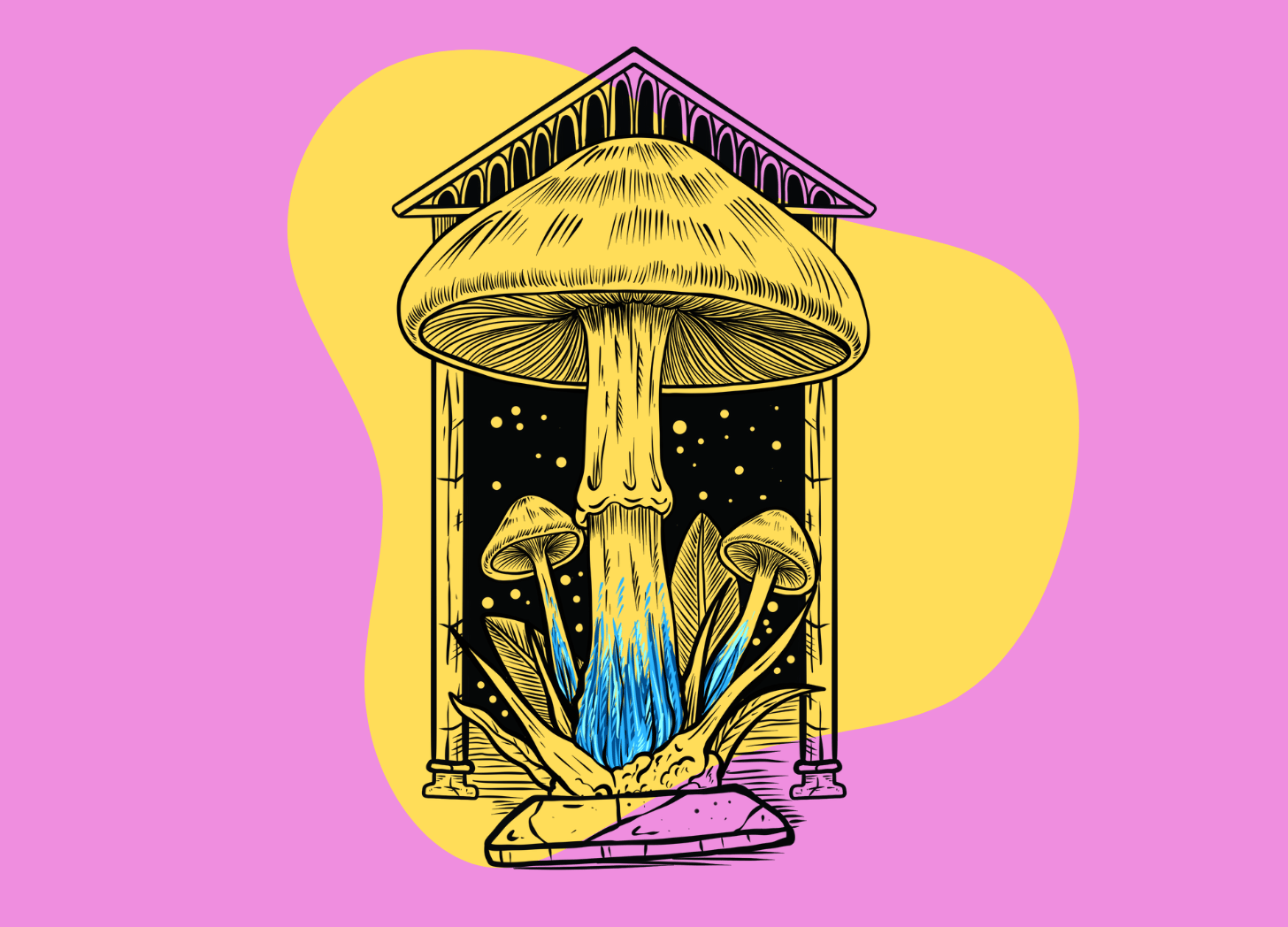Why Do Magic Mushrooms Turn Blue? The Science Behind the Staining
Ever wonder why your magic mushrooms turn blue after a while? Here’s the science behind this fascinating reaction and why it's so significant…
Whether you've harvested them from nature, grown them at home, or picked them up from your local shroom guy, you've probably noticed some blue staining on your magic mushrooms…
Psilocybin-containing mushrooms come in various shapes and sizes, but one constant between strains and species is their unusual reaction to damage.
When magic mushrooms are picked, flicked, or bruised, they turn blue.
Today, we're going to explain WHY your shrooms are turning blue, and how this has become a beacon for amateur shroom hunters looking to identify psilocybin mushrooms in the wild.
The Mysteries of the Magic Mushroom
There are more than 200 individual species of mushrooms that produce psychedelic tryptamines like psilocybin and psilocin. Scientists are still discovering new species, such as the Psilocybe ingeli discovered as recently as 2023.
Not all psychoactive shrooms produce psilocybin and psilocin — for example, the Amanita muscaria (Fly Agaric) makes a totally unrelated compound called muscimol, which is significantly milder than psilocybin but produces its own set of bizarre dream-like visions.
Only magic mushrooms that contain psilocybin and psilocin turn blue.
Some of the most common species of psilocybin-producing mushrooms include:
Gymnopilus junonius (Laughing Gym)
The Science Behind the Bluing Reaction
All psilocybin-containing mushrooms we know of produce a bluish discoloration when bruised or damaged. Whether you’ve harvested Liberty Caps, Blue Meanies, or Cubes, you’ve likely noticed this striking color change near the base or other areas damaged from harvesting or improper handling.
The blueing typically starts on the pileus (cap) and stipe (stem), particularly where the mushroom has been disturbed.
While this phenomenon is well-known among foragers, cultivators, and enthusiasts, the exact cause of the bluing reaction has remained a mystery for decades.
One of the more interesting theories is that certain mushrooms turned blue to look less appealing to animals and insects.
Others more correctly believed it to be a simple oxidation or enzymatic reaction, and many use it as an indicator for the potency of the mushrooms.
While none of these theories are entirely incorrect, the full explanation is a bit more complex…
Why Do Magic Mushrooms Turn Blue?
When magic mushrooms are damaged from environmental factors, harvesting, or handling, their cell walls break open. This exposes the psilocybin within the mushrooms’ flesh to oxygen — triggering an enzymatic reaction where the psilocybin is rapidly converted to its active metabolite, psilocin.
Psilocin itself is highly reactive to oxygen, which is why psilocin levels tend to be very low in dried mushroom samples compared to fresh ones. As psilocin further oxidizes once exposed to air, it breaks down into indigo-colored polymers such as quinoid psilocyl oligomers.
The formation of these pigments result in the characteristic blue staining you'll see on just about every harvested magic mushroom.
Recent studies have identified the specific enzymes responsible for the conversion of psilocybin to psilocin and the rapid oxidation of psilocin to its blue-pigmented form. They're called PsiP and PsiL. These enzymes are a sort of “self-destruct” mechanism for psilocybin — breaking it down when the cell walls of the mushroom are broken.

Is Bluing a Sign of Potency?
A longstanding belief held among shroom hunters and cultivators is that “bluer = stronger.”
While there is some truth to this, it's not as straightforward as you might think.
Let me explain.
The blueing of mushrooms occurs when the psilocybin in the mushroom is exposed to oxygen, causing it to break down into psilocin, which is then further oxidized and forms blue pigments. The enzymes, PsiP and PsiL, convert psilocybin into psilocin and then oxidize it into blue quinoid psilocyl oligomers.
This means the blue color is not a sign of increased potency but rather an indication of psilocybin degradation.
While a mushroom with more intense blue coloration may suggest higher initial psilocybin content, it also means that more of that psilocybin has degraded, thus reducing the mushroom's potency.
Mushrooms with less bruising or blue discoloration may have fewer damaged cells, meaning that their psilocybin has not been oxidized as much, and they may still retain more of their psychoactive properties. It's also important to note that different species may exhibit different blueing reactions regardless of psilocybin potency.
This is why the intensity of blueing isn’t a reliable indicator of potency.
If the mushroom is very blue, it probably was quite potent — but it's not anymore because much of the active ingredients have been destroyed. If the mushroom isn't blue, it doesn't mean the mushroom lacks potency — rather, the psilocybin levels have not yet been oxidized.

How The Blueing Reaction Helps ID Magic Mushroom Species
While blue staining isn't a good indicator of potency, it can be a useful tool for identifying the presence of psilocybin in mushrooms.
Most magic mushroom species display this unique reaction, making it a key identifying characteristic for psychedelic mushroom foragers.
If you decide to head out into nature in search of wild magic mushrooms, you can use the “pinch test” to help identify a suspected psilocybin mushroom. Pinch or scratch the cap and stem of a mushroom — if the damaged areas turn blue within five or ten minutes, it’s a strong indication that the mushroom contains psilocybin.
It’s important to note that bluing alone is not enough to confirm that a suspected mushroom is psychoactive or safe to consume. Some toxic species, such as those in the Galerina genus, contain psilocybin and produce a positive pinch test. However, they also contain potentially toxic compounds that, if ingested, can make you very, very sick.
Other mushrooms, such as Gyroporus cyanescens (the blue-staining bolete), contain no psilocybin at all but will also turn blue when scratched.
On the other hand, some psilocybin species that are considered safe to consume may show little to no bluing when bruised, depending on their age and moisture level.
Assuming a particular mushroom is “magic” and safe to consume just because it turns blue is foolish and dangerous.
If you go in search of psychedelic mushrooms, do not rely on bluing alone. It’s essential to consider other identification factors, such as spore color, cape shape, stem characteristics, and habitat.
Never consume any wild mushroom unless you’re 100% sure of its identity.
For safe and accurate identification, make sure to learn these identifying factors for any species you search for:
Pileus (cap) color
Pileus (cap) shape
Stipe (stem) color
Stipe (stem) shape
Gill color
Gill pattern
Spore print color
Spore shape (under a microscope)
Habitat preferences
Further Reading
Want to learn more about magic mushrooms and how to identify them?
Check out these related articles:
The Dark Truth About Wavy Cap Mushrooms (Psilocybe cyanescens)
Spore Signals: What Mushrooms Reveal About Our Planet's Health
Inside Holland's Psychedelic Subculture: The Curious Dutch Magic Truffle Market
Enjoying Tripsitter? 🍄
Don’t Journey Alone! Tripsitter was built by a community of psychedelic advocates — but it’s people like you that allow us to thrive.
You can also follow us on Bluesky or subscribe to our Reddit.










